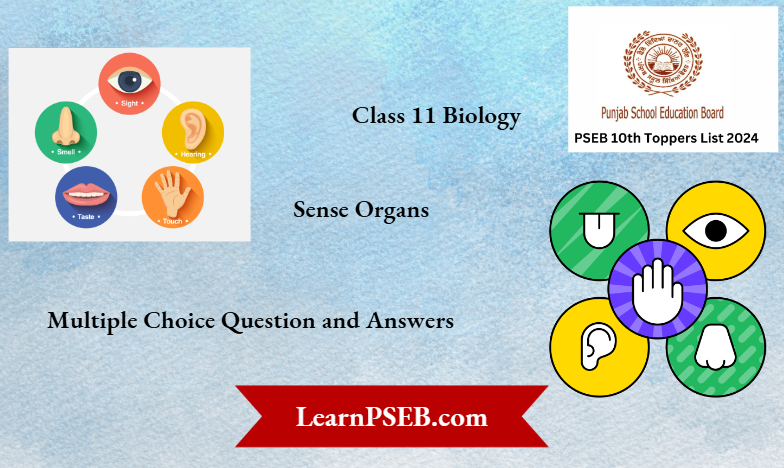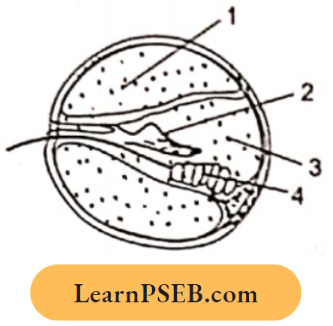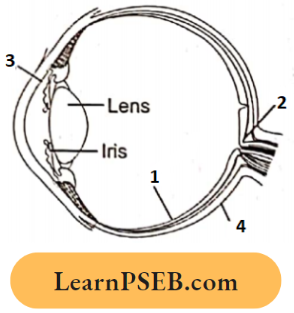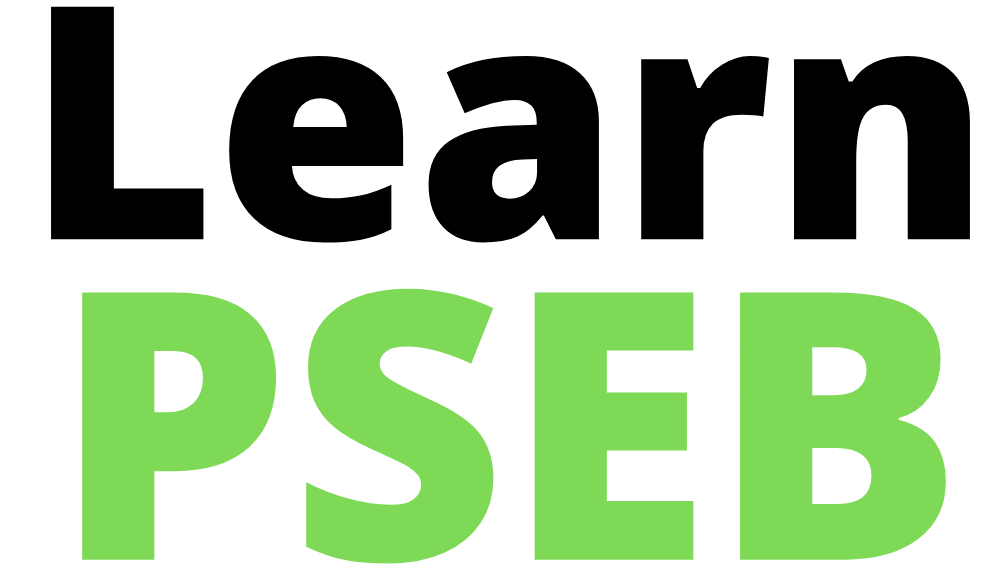Sense Organs Multiple Choice Question and Answers
Question 1. Taste Buds Of The Interior Stile Of Longue In Humans Can Detect:
- Sour Taste
- Bitter Taste
- Sweet Taste
- Saltish Taste.
Answer: 2.
Question 2. Anterior Irregular Wavy Part Of the Retina Is :
- Ora Serrata
- Pars Optica
- Ocular Conjunctiva
- Fovea Centralis.
Answer: 1.
Question 3. Structure That Provides Balance To The Body Is Located In
- Outer Ear
- Middle Ear
- Inner Ear
- Eustachian Tubes.
Answer: 3. Inner Ear
Question 4. When We Migrate From Dark To Light, We Fail To See For Some Time, But After A Time Visibility Becomes Normal. It Is an Example Of the:
- Accommodation
- Adaptation
- Mutation
- Photoperiodism.
Answer: 2. Adaptation
Read And Learn More Class 11 Biology MCQs

Question 5. Characteristic Character Of Human Comea :
- Secreted By Conjunctiva And Glandular
- It Is Lacrimal Gland that secretes Tears
- Blood Circulation Is Absent In Cornea
- In Old Age, It Becomes Hardened And White Layer Deposits On It Which Causes The Cataract.
Answer: 3. Blood Circulation Is Absent In Cornea
Question 6. The Arrangement Of Ear Ossicles In Mammalian Ear Is
- Stapes, Malleus, Incus
- Malleus, Incus, Stapes
- Incus, Malleus, Stapes
- Columella, Malleus, Incus.
Answer: 2. Malleus, Incus, Stapes
PSEB Class 11 Biology Sense Organs MCQs
Question 7. Opacity Of The Lens In The Eyes Leads To :
- Cataract
- Presbyopia
- Astigmatism
- Hyperopia.
Answer: 1. Cataract
Question 8. The Thinnest Skin Is Present On The :
- Eyelids
- Soles Of Feet
- Back Of The Hand
- Forehead.
Answer: 1. Eyelids
Question 9. Which Of The Following Cranial Nerves accepts information From the Corlis Organ?
- Auditory
- Vagus
- Oculomotor
- Trigeminal.
Answer: 1. Auditory
Question 10. Meissner Corpuscles Are Responsible For :
- Heat And Present In Skin
- Cold And Present In Skin
- Pressure And Present In Skin
- Pain And Present In Skin.
Answer: 3. Pressure And Present In Skin
Question 11. The Animals Who Can See Well At Night Have Abundant In Their Eyes.
- Cone Cells
- Scotopic Pigments
- Rod Cells
- Vision Cell.
Answer: 3. Rod Cells
Question 12. Excess Or Less Of Air Pressure In the Car Is Balanced By :
- Custiichinn Tube
- Car Ossicles
- Car Muscles
- Ear Pinna.
Answer: 1. Custiichinn Tube
PSEB Class 11 Biology Chapter Sense Organs MCQs
Question 13. The Receptors Found In The Muscles, Tendons And Joints Are :
- Teloreceptors
- Proprioceptors
- Intcroccptors
- Thermoreceptors.
Answer: 2. Proprioceptors
Question 14. When The Intensity Of Light Is Low During Night The Light Is Detected By :
- Rods
- Cones
- Lens
- Both 1 And 2.
Answer: 1. Rods
Question 15. Which Of The Following Is Concerned With Static Equilibrium?
- Semicircular Canals And Cochlea
- Semicircular Canals And Utricle
- Lagena And Sacculus
- Otolith And Lagena.
Answer: 2. Semicircular Canals And Utricle
Question 16. Ommatidia Serve The Purpose Of Photoreception In :
- Frog
- Sunflower
- Cockroach
- Human.
Answer: 3. Cockroach
PSEB Class 11 Biology Sense Organs MCQs
Question 17. Human Ear Is Equipped To Register Sounds Of Frequencies Per Second Between :
- 20-20000 Cycles
- 1000-2000 Cycles
- 5000-7000 Cycles
- 5000-10000 Cycles.
Answer: 1. 20-20000 Cycles
Question 18. Retina Is Similar To Which Part Of Camera?
- Lens
- Film
- Flash
- Shutter.
Answer: 2. Film
Question 19. Sensory Cells For Picking Up Sound Vibrations Are Present In :
- Utriculus
- Cochlea
- Sacculus
- Semicircular Canal.
Answer: 2. Cochlea
Question 20. Circular Ciliary Muscles Of the Eye Are Unable To Contract. It Will Result In :
- Impairment Of Vision
- Making Lens More Convex
- Making Lens Thin And Stretched
- No Effect Of Bright Light On Retina.
Answer: 3. Making Lens Thin And Stretched
Question 21. The Point In the eyeball from Which the Optic Nerve And Blood Vessels Leave Is :
- Pass Optica
- Pupil
- Blind Spot
- Yellow Spot.
Answer: 3. Blind Spot
Question 22. In A Man, Abducens Nerve Is Injured. Which One Of The Following Functions Will Be Affected?
- Movement Of The Eye Ball
- Swallowing
- Movement Of The Longue
- Movement Of The Neck
Answer: 1. Movement Of The Eye Ball
Question 23. Internal Ear Is Filled With
- Perilymph
- Endolymph
- Lymph
- Both 1 And 2
Answer: 2. Endolymph
Question 24. Rods And Cones Of Eye Are Modified:
- Multipolar Neuron
- Unipolar Neuron
- Bipolar Neuron
- None Of These.
Answer: 2. Unipolar Neuron
Question 25. Sense Of Smell Is Perceived By :
- Pituitary
- Hypothalamus
- Olfactory Lobe
- Cerebrum.
Answer: 3. Olfactory Lobe
Sense Organs Multiple Choice Questions PSEB Class 11
Question 26. Ora Sonata Is :
- Gland Present In The Oral Cavity Of Frog
- A Part Of The Third Wall Of the Retina Of the Eye
- Present In Utriculus Of Ear
- Oral Cavity Of Protochordates
Answer: 2. A Part Of the Third Wall Of the Retina Of the Eye
Question 27. Adaptation Of Eyes In Dark Is Due To :
- Depletion Of Vision Pigment In Rods
- Depletion Of Vision Pigment In Cones
- Repletion Of Vision Pigment In Rods
- Repletion Of Vision Pigment In Cones.
Answer: 3. Repletion Of Vision Pigment In Rods
Question 28. Feelings Of Anger, Pain And Pleasure Are Experienced Through :
- Limbic System
- Frontal Lobe
- Parietal Lobe
- Reticular System.
Answer: 1. Limbic System
Question 29. In Which Of Following Only Cone Cells Are Found?
- Fovea Centralis
- Retina
- Fossa ovalis
- Blind Spots.
Answer: 1. Fovea Centralis
Question 30. Bowman’s Glands Are Found In :
- External Autjitary Canal
- Cortical Nephrons Only
- Juxtamedu]Lpy Nephrons
- Olfactory Epithelium.
Answer: 4. Olfactory Epithelium.
Question 31. Identity’ The Correct Sequence Of Organs/Regions In The Organization Of Human Ear As An Auditory MechanoReceptor Organ :
- Pinna-Cochlea-Tympanic Membrane-Audiory Canal-Malleus-Stapes-Incus-Auditory Nerve
- Pinna-Auditory Canal-Tympanic Membrane- Malleus-Incus-Stapes-Cochlea-Auditory Nerve
- Pinna-Tympanic Membrane-Auditory Canal-Incus- Malleus-Stapes-Cochlea-Auditory Nerve
- Pinna-Tympanic Membrane-Auditory Canal- Cochls-Malleus-Lncus-Stapes-Auditory Nerve.
- Pinna-Malleus-Incus-Stapes-Auditory Canal- Tympanic Membrane-Cochlea-Auditory Nerve.
Answer: 2. Pinna-Auditory Canal-Tympanic Membrane- Malleus-Incus-Stapes-Cochlea-Auditory Nerve
Question 32. Muller’s Cells Occur In :
- Heart
- Retina
- Kidney
- Pancreas.
Answer: 2. Retina
Sense Organs Multiple Choice Questions PSEB Class 11
Question 33. Jacobson’s Otguns Which Arc Additional Olfactory Organs Ate Present In :
- Rat
- Man
- Snake
- All Of These.
Answer: 3. Snake
Question 34. Given Below Is A Diagrammatic Cross Section Of A Single Limp Of Human Cochlea Which One Of The Following Options Correctly Re-Presents The Names Of Three Different Parts?

- 4: Sensory Hair Cells, 2: Endolymph 2: Tectorial Membrane 4 Semom Air Cell
- 1: Perilymph, 2 Tectorial Membrane 3: Endolymph 4. Secretory Hair Cells
- 2: Tectorial Membrane, 3: Parilymph, 4 Secretory Cells
- 3: Endolymph, 5: Sensory Hair Cells, 1: Serum.
Answer: 2. 1: Perilymph, 2 Tectorial Membrane 3: Endolymph 4. Secretory Hair Cells
Question 35. Fovea In The Eye Is A Central Pit In The Yellowish Pigmented Spot Called
- Blind Spot
- Retina
- Cornea
- Macula Lutea
- Choroid.
Answer: 4. Choroid.
Question 36. The Purplish Red Pigment Rhodopsin Contained In The Rods Type Of Photoreceptor Cells Of The Human Eye, Is A Derivative Of :
- Vitamin B,
- Vitamin C
- Vitamin D
- Vitamin A
Answer: 4. Vitamin A
PSEB Class 11 Biology Chapter Sense Organs MCQs
Question 37. Parts A, B, C And D Of The Human Eye Are Shown In The Diagram. Select The Option Which Gives Correct Identification Along With Its Functions/Characteristics :

- 2-Blind Spot-Has Only A Few Rods And Cones.
- 3-Aqueous Chamber- Reflects The Light Which Does Not Pass Through The Lens.
- 4-Choroid- The Anterior Part Forms the Ciliary Body.
- 1-Retina – Contains Photoreceptors – Rods And Cones.
Answer: 4. A-Retina – Contains Photoreceptors – Rods And Cones.
